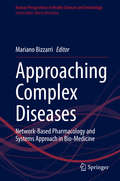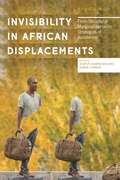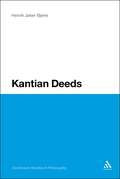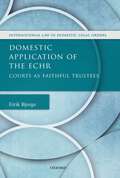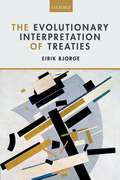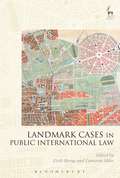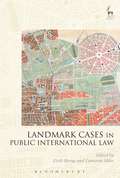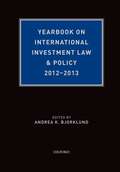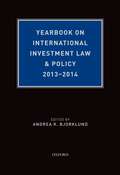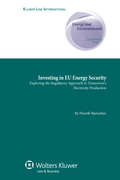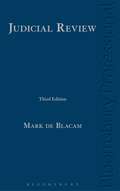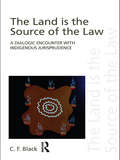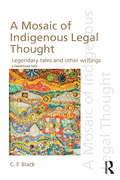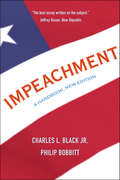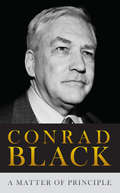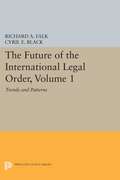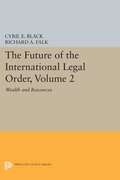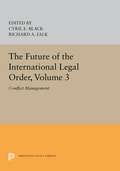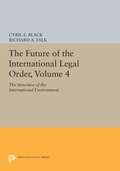- Table View
- List View
Approaching Complex Diseases: Network-Based Pharmacology and Systems Approach in Bio-Medicine (Human Perspectives in Health Sciences and Technology #2)
by Mariano BizzarriThis volume – for pharmacologists, systems biologists, philosophers and historians of medicine – points to investigate new avenues in pharmacology research, by providing a full assessment of the premises underlying a radical shift in the pharmacology paradigm. The pharmaceutical industry is currently facing unparalleled challenges in developing innovative drugs. While drug-developing scientists in the 1990s mostly welcomed the transformation into a target-based approach, two decades of experience shows that this model is failing to boost both drug discovery and efficiency. Selected targets were often not druggable and with poor disease linkage, leading to either high toxicity or poor efficacy. Therefore, a profound rethinking of the current paradigm is needed. Advances in systems biology are revealing a phenotypic robustness and a network structure that strongly suggest that exquisitely selective compounds, compared with multitarget drugs, may exhibit lower than desired clinical efficacy. This appreciation of the role of polypharmacology has significant implications for tackling the two major sources of attrition in drug development, efficacy and toxicity. Integrating network biology and polypharmacology holds the promise of expanding the current opportunity space for druggable targets.
Invisibility in African Displacements: From Structural Marginalization to Strategies of Avoidance (Africa Now)
by Jesper Bjarnesen Simon TurnerAfrican migrants have become increasingly demonised in public debate and political rhetoric. There is much speculation about the incentives and trajectories of Africans on the move, and often these speculations are implicitly or overtly geared towards discouraging and policing their movements. What is rarely understood or scrutinised however, are the intricate ways in which African migrants are marginalised and excluded from public discourse; not only in Europe but in migrant-receiving contexts across the globe.Invisibility in African Displacements offers a series of case studies that explore these dynamics. What tends to be either ignored or demonised in public debates on African migration are the deliberate strategies of avoidance or assimilation that migrants make use of to gain access to the destinations or opportunities they seek, or to remain below the radar of restrictive governance regimes.This books offers fine-grained analysis of the ways in which African migrants negotiate structural and strategic invisibilities, adding innovative approaches to our understanding of both migrant vulnerabilities and resilience.
Invisibility in African Displacements: From Structural Marginalization to Strategies of Avoidance (Africa Now)
by Jesper Bjarnesen Simon TurnerAfrican migrants have become increasingly demonised in public debate and political rhetoric. There is much speculation about the incentives and trajectories of Africans on the move, and often these speculations are implicitly or overtly geared towards discouraging and policing their movements. What is rarely understood or scrutinised however, are the intricate ways in which African migrants are marginalised and excluded from public discourse; not only in Europe but in migrant-receiving contexts across the globe.Invisibility in African Displacements offers a series of case studies that explore these dynamics. What tends to be either ignored or demonised in public debates on African migration are the deliberate strategies of avoidance or assimilation that migrants make use of to gain access to the destinations or opportunities they seek, or to remain below the radar of restrictive governance regimes.This books offers fine-grained analysis of the ways in which African migrants negotiate structural and strategic invisibilities, adding innovative approaches to our understanding of both migrant vulnerabilities and resilience.
Kantian Deeds (Continuum Studies in Philosophy)
by Henrik Jøker BjerreKantian Deeds revokes and renews the tradition of Kant's moral philosophy. Through a novel reading of contemporary approaches to Kant, Henrik Bjerre draws a new map of the human capacity for morality. Morality consists of two different abilities that are rarely appreciated at the same time. Human beings are brought up and initiated into a moral culture, which gives them the cognitive mapping necessary to act morally and responsibly. They also, however, acquire an ability to reach beyond that which is considered moral and thus develop an ability to reinterpret or break 'normal' morality. By drawing on two very different resources in contemporary philosophy - more conservative trends in analytic philosophy and more radical sources in recent works of psychoanalytically informed philosophy - and claiming that they must be read together, Kantian Deeds provides a new understanding of what is termed 'the structure of moral revolutions'. Essentially, deeds are revolutionary changes of moral character that can only be performed by such creatures that have acquired one.
Domestic Application of the ECHR: Courts as Faithful Trustees (International Law and Domestic Legal Orders)
by Eirik BjorgeDomestic courts are entrusted with the application of the European Convention on Human Rights (ECHR), as faithful trustees of the rights protected in the Convention. This book analyses the way in which the domestic courts in the United Kingdom, France, and Germany apply the ECHR and how, applying the Convention, they define their relationship with the European Court of Human Rights. Contrary to what others have contended, the book argues that it is not true descriptively, nor desirable normatively, that the domestic courts approach the ECHR based upon friction and assertion of sovereignty vis-à-vis the European Court. The proper role played by the domestic courts, and the one which they have taken on them to perform in fact, is to apply the Convention in all good faith, building on the principles of the Convention as set out in the jurisprudence of the European Court. But if domestic courts are in a position to apply the ECHR in the first place, it is because the application of the Convention has been entrusted to them by the other organs of the municipal state; in certain cases municipal principles of the separation of powers have an important bearing on domestic interpretation and application of the Convention. Domestic Application of the ECHR: Courts as Faithful Trustees shows that, through their faithful application of the ECHR, domestic courts can - and do - make a positive contribution to the development of the law of the Convention.
Domestic Application of the ECHR: Courts as Faithful Trustees (International Law and Domestic Legal Orders)
by Eirik BjorgeDomestic courts are entrusted with the application of the European Convention on Human Rights (ECHR), as faithful trustees of the rights protected in the Convention. This book analyses the way in which the domestic courts in the United Kingdom, France, and Germany apply the ECHR and how, applying the Convention, they define their relationship with the European Court of Human Rights. Contrary to what others have contended, the book argues that it is not true descriptively, nor desirable normatively, that the domestic courts approach the ECHR based upon friction and assertion of sovereignty vis-à-vis the European Court. The proper role played by the domestic courts, and the one which they have taken on them to perform in fact, is to apply the Convention in all good faith, building on the principles of the Convention as set out in the jurisprudence of the European Court. But if domestic courts are in a position to apply the ECHR in the first place, it is because the application of the Convention has been entrusted to them by the other organs of the municipal state; in certain cases municipal principles of the separation of powers have an important bearing on domestic interpretation and application of the Convention. Domestic Application of the ECHR: Courts as Faithful Trustees shows that, through their faithful application of the ECHR, domestic courts can - and do - make a positive contribution to the development of the law of the Convention.
The Evolutionary Interpretation of Treaties
by Eirik BjorgeIf an old treaty regulating 'commerce' or forbidding 'degrading treatment of persons' is to be interpreted decades after its conclusion, does 'commerce' or 'degrading treatment of persons' have the same meaning at the time of interpretation as they had when the treaty was concluded? The evolutionary interpretation of treaties has proven one of the most controversial topics in the practice of international law. Indeed, it has been seen as going against the very grain of the law of treaties, and has been argued to be contrary to the intention of the parties, breaching the principle of consent. This book asks what the place of evolutionary interpretation is within the understanding of treaties, at a time when many important international legal instruments are over five decades old. It sets out to place the evolutionary interpretation of treaties on a firm footing within the Vienna rules of interpretation, as codified in Articles 3133 of the Vienna Convention on the Law of Treaties. The book demonstrates that the evolutionary interpretation of treatiesin common with all other types of interpretationis in fact based upon an objective understanding of the intention of the parties. In order to marry intention and evolution, the book argues that, on the one hand, evolutionary interpretation is the product of the correct application of Articles 3133 and, on the other, that Articles 3133 are geared towards the objective establishment of the intention of the parties. The evolutionary interpretation of treaties is therefore shown to represent an intended evolution.
The Evolutionary Interpretation of Treaties
by Eirik BjorgeIf an old treaty regulating 'commerce' or forbidding 'degrading treatment of persons' is to be interpreted decades after its conclusion, does 'commerce' or 'degrading treatment of persons' have the same meaning at the time of interpretation as they had when the treaty was concluded? The evolutionary interpretation of treaties has proven one of the most controversial topics in the practice of international law. Indeed, it has been seen as going against the very grain of the law of treaties, and has been argued to be contrary to the intention of the parties, breaching the principle of consent. This book asks what the place of evolutionary interpretation is within the understanding of treaties, at a time when many important international legal instruments are over five decades old. It sets out to place the evolutionary interpretation of treaties on a firm footing within the Vienna rules of interpretation, as codified in Articles 3133 of the Vienna Convention on the Law of Treaties. The book demonstrates that the evolutionary interpretation of treatiesin common with all other types of interpretationis in fact based upon an objective understanding of the intention of the parties. In order to marry intention and evolution, the book argues that, on the one hand, evolutionary interpretation is the product of the correct application of Articles 3133 and, on the other, that Articles 3133 are geared towards the objective establishment of the intention of the parties. The evolutionary interpretation of treaties is therefore shown to represent an intended evolution.
Landmark Cases in Public International Law (Landmark Cases)
by Eirik Bjorge Cameron MilesThe past two hundred years have seen the transformation of public international law from a rule-based extrusion of diplomacy into a fully-fledged legal system. Landmark Cases in Public International Law examines decisions that have contributed to the development of international law into an integrated whole, whilst also creating specialised sub-systems that stand alone as units of analysis. The significance of these decisions is not taken for granted, with contributors critically interrogating the cases to determine if their reputation as 'landmarks' is deserved. Emphasis is also placed on seeing each case as a diplomatic artefact, highlighting that international law, while unquestionably a legal system, remains reliant on the practice and consent of states as the prime movers of development.The cases selected cover a broad range of subject areas including state immunity, human rights, the environment, trade and investment, international organisations, international courts and tribunals, the laws of war, international crimes, and the interface between international and municipal legal systems. A wide array of international and domestic courts are also considered, from the International Court of Justice to the European Court of Human Rights, World Trade Organization Appellate Body, US Supreme Court and other adjudicative bodies. The result is a three-dimensional picture of international law: what it was, what it is, and what it might yet become.
Landmark Cases in Public International Law (Landmark Cases)
by Eirik Bjorge Cameron MilesThe past two hundred years have seen the transformation of public international law from a rule-based extrusion of diplomacy into a fully-fledged legal system. Landmark Cases in Public International Law examines decisions that have contributed to the development of international law into an integrated whole, whilst also creating specialised sub-systems that stand alone as units of analysis. The significance of these decisions is not taken for granted, with contributors critically interrogating the cases to determine if their reputation as 'landmarks' is deserved. Emphasis is also placed on seeing each case as a diplomatic artefact, highlighting that international law, while unquestionably a legal system, remains reliant on the practice and consent of states as the prime movers of development.The cases selected cover a broad range of subject areas including state immunity, human rights, the environment, trade and investment, international organisations, international courts and tribunals, the laws of war, international crimes, and the interface between international and municipal legal systems. A wide array of international and domestic courts are also considered, from the International Court of Justice to the European Court of Human Rights, World Trade Organization Appellate Body, US Supreme Court and other adjudicative bodies. The result is a three-dimensional picture of international law: what it was, what it is, and what it might yet become.
Importing EU Norms: Conceptual Framework and Empirical Findings (United Nations University Series on Regionalism #8)
by Annika Björkdahl Natalia Chaban John Leslie Annick MasselotThis interdisciplinary work presents a conceptual framework and brings together constructivist and rationalist accounts of how EU norms are adopted, adapted, resisted or rejected. These chapters provide empirical cases and critical analysis of a rich variety of norm-takers from EU member states, European and non-European states, including the rejection of EU norms in Russia and Africa as well as adaptation of EU practices in Australia and New Zealand. Chapters on China, ASEAN and the Czech Republic demonstrate resistance to EU norm export. This volume probes differences in willingness to adopt or adapt norms between various actors in the recipient state and explores such questions as: How do norm-takers perceive of the EU and its norms? Is there a ‘normative fit’ between EU norms and the local normative context? Similarly, how do EU norms impact recipients’ interests and institutional arrangements? First, the authors map EU norm export strategies and approaches as they affect norm-takers. Second, the chapters recognize that norm adoption, adaption, resistance or rejection is a product of interaction and a relationship in which interdependence, asymmetry and power play a role. Third, we see that domestic circumstances within norm-takers condition the reception of norms. This book’s focus on norm-takers highlights the reflexive nature of norm diffusion and that nature has implications for the EU itself as a norm exporter. Anyone with an interest in the research agenda on norm diffusion, normative power and the EU’s normative dialogue with the world will find this book highly valuable, including scholars, policy makers and students of subjects including political science, European studies, international relations and international and EU law.
Yearbook on International Investment Law & Policy 2012-2013 (Yearbook on International Investment Law and Policy)
by Andrea BjorklundToday, international investment law consists of a network of multifaceted, multilayered international treaties that, in one way or another, involve virtually every country of the world. The evolution of this network raises a host of issues regarding international investment law and policy, especially in the area of international investment disputes. The Yearbook on International Investment Law & Policy 2012-2013 monitors current developments in international investment law and policy, focusing on recent trends and issues in foreign direct investment (FDI). With contributions by leading experts in the field, this title provides timely, authoritative information on FDI that can be used by a wide audience, including practitioners, academics, researchers, and policy makers. Contributions to the Yearbook on International Investment Law & Policy 2012-2013 cover the 2012-2013 trends in international investment agreements, the Foreign Direct Investment (FDI) trends, and the challenge of investment policies for outward FDI, as well as a review of 2012 international investment law and arbitration. This edition contains essays from the Symposium on Sustainable Development and International Investment Law: Bridging the Divide. Also included are general articles providing an analysis of arbitral tribunal practice regarding the applicable law to state contracts under the ICSID Convention in the Twenty First Century; the role of municipal laws in investment arbitration; the status of state-controlled entities under international investment law, the US and the Trans-Pacific partnership (TPP); new 2012 US Model BITs; and the Regulation of FDI in Bolivia. This volume concludes with the winning memorials from the 2012 FDI International Moot Competition.
Yearbook on International Investment Law & Policy, 2013-2014 (Yearbook on International Investment Law and Policy)
by Andrea K. BjorklundInternational investment law today consists of a network of multifaceted, multilayered international treaties that, in one way or another, involve virtually every country of the world. The evolution of this network raises a host of issues regarding international investment law and policy, especially in the area of international investment disputes. The Yearbook on International Investment Law & Policy 2013-2014 monitors current developments in international investment law and policy, focusing on recent trends and issues in foreign direct investment (FDI). With contributions by leading experts in the field, this title provides timely, authoritative information on FDI that can be used by a wide audience, including practitioners, academics, researchers, and policy makers. The 2013-2014 Yearbook begins with trends in international investment and the activities of multinational enterprises, a review of trends and new approaches in international investment agreements for 2013-2014, and a review of international investment law and arbitration for 2013. This edition contains a sample of the research and ideas generated by the Investment Treaty Forum at the British Institute of International and Comparative Law--The Investment Treaty Forum brings together experts in international investment law to engage in high-level debate about salient topics in investment law. This edition covers many important topics, such as the principle of proportionality and the problem of indeterminacy in international investment treaties; proportionality, reasonableness and standards of review in investment treaty arbitration; and the role of investors' legitimate expectations in defense of investment treaty claims. The general articles included in this volume provide analysis of balancing investor protection and regulatory freedom in international investment law. The jurisprudential interaction between ICSID tribunals and the International Court of Justice are also discussed, along with inconsistencies in investor-state awards, the role of state interpretations; old and new ways for host states to defend against investment arbitrations, and approaches and analogies in the countermeasures defense in investor-state disputes. This volume explores the political economy of crises and the international law of necessity after the great recession. In addition to this are articles on minilateral treaty-making and bilateral investment treaties; investment promotion, agencies; the trend toward open contracting; and new regulations on foreign acquisitions of land in Brazil and Argentina. This volume concludes with the winning memorials from the 2013 FDI International Moot Competition.
Investing in EU Energy Security: Exploring the Regulatory Approach to Tomorrow’s Electricity Production
by Henrik BjørnebyeThe author of this timely and sharply focused book shows that, in the light of our current knowledge, ensuring new investments – and the right investments – in electricity generation constitutes an urgent energy policy challenge facing the EU over the coming decades. He accordingly makes the case for a serious reconsideration of the market facilitation and market intervention rules under electricity market legislation in the EU. In the first detailed legal analysis of the EU’s internal electricity market framework for investments in electricity generation facilities from the perspective of security of supply, this book cover such legal issues as the following in precise detail: applicability of the Treaty on the Functioning of the European Union (TFEU); security of supply as a ground for exemption on the basis of public security; justifications of public intervention; the applicability of EU State aid provisions to investments in energy security; requirements imposed by EU law on Member States for ensuring cost-efficient investments in European supply security; facilitation of renewable energy sources and cogeneration in the environmental interest; the Court of Justice’s approach to Member State interventions; the Court’s decisions on restrictions on free movement in the environmental interest; Member States’ right to launch tendering procedures for new generation capacity; Member States’ right to impose public service obligations in the general economic interest on certain undertakings; and relationship between the provisions of the TFEU and those of the Euratom Treaty in relation to investments in nuclear power generation. Throughout the study, in addition to his analysis of the decisions of the Court of Justice and the Court of First Instance, the author takes into account legal literature and Union reports, preparatory works, and working papers. The book demonstrates convincingly that today’s energy supply challenges must be based on a broader balancing of security, competitiveness and sustainability interests. It suggests that the internal electricity market provisions of the Electricity Directive and the Security of Electricity Supply Directive would benefit from focusing more intensely on requiring investments in technologies and primary energy sources that will help mitigate climate change and reduce European energy import dependency, and less on the need for ensuring cost-efficient investments through market-based means
Judicial Review: (third Edition)
by Mark De BlacamJudicial Review, Third Edition covers the grounds for review, defences to an application, the remedies and procedures involved and covers the Rules of the Superior Courts 2011, SI 691/2011. It is the definitive text on judicial review available in Ireland and also of important reference in the United Kingdom. Covers the following:The Review Framework;Review for Error;Review for Unfairness;Review for Breach of Fundamental Rights;Review for Unreasonableness and Abuse of Power;Review for Breach of European Law;Defences to an Application;Procedure;Procedure in Special Cases under Statute.Previous print edition ISBN: 9781847661432
The Land is the Source of the Law: A Dialogic Encounter with Indigenous Jurisprudence
by C.F. BlackThe Land is the Source of Law brings an inter-jurisdictional dimension to the field of indigenous jurisprudence: comparing Indigenous legal regimes in New Zealand, the USA and Australia, it offers a ‘dialogical encounter with an Indigenous jurisprudence’ in which individuals are characterised by their rights and responsibilities into the Land. Though a relatively "new" field, indigenous jurisprudence is the product of the oldest continuous legal system in the world. Utilising a range of texts – films, novels, poetry, as well as "law stories" CF Black blends legality and narrative in order to redefine jurisprudentia in indigenous terms. This re-definition gives shape to the jurisprudential framework of the book: a shape that is not just abstract, but physical and metaphysical; a shape that is circular and concentric at the same time. The outer circle is the cosmology, so that the human never forgets that they are inside a universe – a universe that has a law. This law is found in the second circle which, whilst resembling the ancient Greek law of physis is a law based on relationship. This is a relationship that orders the placing of the individual in the innermost circle, and which structures their rights and responsibilities into the land. The jurisprudential texts which inform the theoretical framework of this book bring to our attention the urgent message that the Djang (primordial energy) is out of balance, and that the rebalancing of that Djang is up to the individual through their lawful behaviour, a behaviour which patterns them back into land. Thus, The Land is the Source of the Law concludes not only with a diagnosis of the cause of climate change, but a prescription which offers an alternative legal approach to global health.
The Land is the Source of the Law: A Dialogic Encounter with Indigenous Jurisprudence
by C.F. BlackThe Land is the Source of Law brings an inter-jurisdictional dimension to the field of indigenous jurisprudence: comparing Indigenous legal regimes in New Zealand, the USA and Australia, it offers a ‘dialogical encounter with an Indigenous jurisprudence’ in which individuals are characterised by their rights and responsibilities into the Land. Though a relatively "new" field, indigenous jurisprudence is the product of the oldest continuous legal system in the world. Utilising a range of texts – films, novels, poetry, as well as "law stories" CF Black blends legality and narrative in order to redefine jurisprudentia in indigenous terms. This re-definition gives shape to the jurisprudential framework of the book: a shape that is not just abstract, but physical and metaphysical; a shape that is circular and concentric at the same time. The outer circle is the cosmology, so that the human never forgets that they are inside a universe – a universe that has a law. This law is found in the second circle which, whilst resembling the ancient Greek law of physis is a law based on relationship. This is a relationship that orders the placing of the individual in the innermost circle, and which structures their rights and responsibilities into the land. The jurisprudential texts which inform the theoretical framework of this book bring to our attention the urgent message that the Djang (primordial energy) is out of balance, and that the rebalancing of that Djang is up to the individual through their lawful behaviour, a behaviour which patterns them back into land. Thus, The Land is the Source of the Law concludes not only with a diagnosis of the cause of climate change, but a prescription which offers an alternative legal approach to global health.
A Mosaic of Indigenous Legal Thought: Legendary Tales and Other Writings
by C.F. BlackThis book offers an Indigenous supplement to the rich and growing area of visual legal scholarship. Organized around three narratives, each with an associated politico-poetic reading, the book addresses three major global issues: climate change, the trade in human body parts and bio-policing. Manifesting and engaging the traditional storytelling mode of classical Indigenous ontology, these narratives convey legal and political knowledge, not merely through logical argument, but rather through the feelings of law and the understanding of lawful behaviour produced by their rhythm. Through its own performativity, therefore, the book demonstrates how classical Indigenous legal traditions remain vital to the now pressing challenge of making peace with the earth.
A Mosaic of Indigenous Legal Thought: Legendary Tales and Other Writings
by C.F. BlackThis book offers an Indigenous supplement to the rich and growing area of visual legal scholarship. Organized around three narratives, each with an associated politico-poetic reading, the book addresses three major global issues: climate change, the trade in human body parts and bio-policing. Manifesting and engaging the traditional storytelling mode of classical Indigenous ontology, these narratives convey legal and political knowledge, not merely through logical argument, but rather through the feelings of law and the understanding of lawful behaviour produced by their rhythm. Through its own performativity, therefore, the book demonstrates how classical Indigenous legal traditions remain vital to the now pressing challenge of making peace with the earth.
Impeachment: A Handbook, New Edition
by Charles L., BlackOriginally published at the height of the Watergate crisis, Charles Black’s classic Impeachment: A Handbook has long been the premier guide to the subject of presidential impeachment. Now thoroughly updated with new chapters by Philip Bobbitt, it remains essential reading for every concerned citizen. Praise for Impeachment: “To understand impeachment, read this book. It shows how the rule of law limits power, even of the most powerful, and reminds us that the impact of the law on our lives ultimately depends on the conscience of the individual American.”—Bill Bradley, former United States senator “The most important book ever written on presidential impeachment.”—Lawfare “A model of how so serious an act of state should be approached.”—Wall Street Journal “A citizen’s guide to impeachment. . . . Elegantly written, lucid, intelligent, and comprehensive.”—New York Times Book Review “The finest text on the subject I have ever read.”—Ben Wittes Charles L. Black, Jr. (1915–2001), was Sterling Professor of Law at Yale Law School. Philip Bobbitt is the Herbert Wechsler Professor of Federal Jurisprudence at Columbia Law School.
A Matter of Principle
by Conrad BlackIn 1993, Conrad Black was the proprietor of London's Daily Telegraph and the head of one of the world's largest newspaper groups. In 2004, however, he was accused of fraud and fired as chairman of Hollinger. In A Matter of Principle, Black describes his indictment, four-month trial, partial conviction, imprisonment and largely successful appeal. Black writes without reserve about the prosecutors who mounted a campaign to destroy him and the journalists who presumed he was guilty. Fascinating people fill these pages, from prime ministers and presidents to the social, legal and media elite. Woven throughout are Black's views on big themes: politics, corporate governance and the US justice system. He is candid about highly personal subjects, including his friendships, his faith and his marriage to Barbara Amiel. Above all, Black maintains his innocence and recounts what he describes as the 'fight of and for my life'. A Matter of Principle is a riveting memoir and a scathing account of a flawed justice system.
The Future of the International Legal Order, Volume 1: Trends and Patterns
by Cyril E. BlackThis is the first volume in a large-scale collaborative research project intended to focus the attention of international lawyers and social scientists on the near future of the international legal order. Sponsored by Princeton University with support from the Ford Foundation, the project seeks to stimulate research and provide an intellectual focus for the elucidation of the constructive role law can play in maintaining peace and improving welfare and dignity in the world. The contributors have been urged to engage in their respective areas of expertise in non-utopian forecasting that will enable law to contribute more creatively, by anticipating the range of feasible responses, to the solution of emerging problems in the international environment.Originally published in 1969.The Princeton Legacy Library uses the latest print-on-demand technology to again make available previously out-of-print books from the distinguished backlist of Princeton University Press. These editions preserve the original texts of these important books while presenting them in durable paperback and hardcover editions. The goal of the Princeton Legacy Library is to vastly increase access to the rich scholarly heritage found in the thousands of books published by Princeton University Press since its founding in 1905.
The Future of the International Legal Order, Volume 2: Wealth and Resources
by Cyril E. Black Richard A. FalkWolfgang Friedmann, Burns H. Weston, William T. Burke, and Ivan A. Vlasic explore the new frontiers and wealth and resources that are altering the patterns of the world economy.Since rapid and dramatic technological progress poses problems that can be solved only by international or multinational controls these legal specialists emphasize the urgent need for nonviolent measures capable of reconciling the interests of the wealthy and impoverished nations and of satisfying the rising demands of the underdeveloped world for participation in the scientific revolution. The existing situation and current trends are described, and detailed recommendations to strengthen the role of international law in the decades ahead are made.Originally published in 1970.The Princeton Legacy Library uses the latest print-on-demand technology to again make available previously out-of-print books from the distinguished backlist of Princeton University Press. These editions preserve the original texts of these important books while presenting them in durable paperback and hardcover editions. The goal of the Princeton Legacy Library is to vastly increase access to the rich scholarly heritage found in the thousands of books published by Princeton University Press since its founding in 1905.
The Future of the International Legal Order, Volume 3: Conflict Management (Princeton Legacy Library #5369)
by Cyril E. Black Richard A. FalkThe eleven contributors to this volume come to grips with the hard realities of controlling war in our modern, interrelated world. All of them deal directly with the role of law in the management of conflict. From Cyril E. Black's introductory chapter, "Conflict Management and World Order," to Richard J. Barnet's concluding chapter, "Toward the Control of International Violence: The Limits and the Possibilities of Law," each expert moves from analysis of some immediate problem of international legal control to the direct application of law to war.The contributors include Tom J. Farer, Rosalyn Higgins, John Norton Moore, Daniel Wiles, William B. Bader, Arnold Kramish, Mason Willrich, W. Michael Reisman, and Harold Feiveson.Conflict Management is the third volume in a large-scale collaborative research project intended to focus the attention of international lawyers and social scientists on the near future of the international legal order. A brochure describing the entire series is available.Cyril E. Black is Duke Professor of Russian History and Director of the Center of International Studies, Princeton University. Richard A. Falk is Milbank Professor of International Law and Practice, Princeton University.Written under the auspices of the Center of Interntional Studies, Princeton University.Originally published in 1971.The Princeton Legacy Library uses the latest print-on-demand technology to again make available previously out-of-print books from the distinguished backlist of Princeton University Press. These editions preserve the original texts of these important books while presenting them in durable paperback and hardcover editions. The goal of the Princeton Legacy Library is to vastly increase access to the rich scholarly heritage found in the thousands of books published by Princeton University Press since its founding in 1905.
The Future of the International Legal Order, Volume 4: The Structure of the International Environment
by Cyril E. Black Richard A. FalkThe issues of conflict management treated in this volume are relatively recent consequences of the scientific and technological revolution, and are in significant respects unprecedented in man's history: food distribution, population, ocean resources, air and water pollution. Such new global problems cannot be adequately solved except by international effort—effort that requires adjustments in the present international system.What adjustments arc practicable, and at least minimally necessary, are assessed by seventeen lawyers and specialists in international affairs. They approach the subject from two perspectives: the international legal aspects of man in his environment; and the institutions, agencies, and movements that must be further adapted to the rapidly changing needs of mankind.Contributors: Harold Lasswell, Mary Ellen Caldwell, Dennis Livingston, Howard J. and Rita F. Taubenfeld, L.F.E. Goldie. Leon Gordenker, John Carey, Hans Baade, Gidon Gotlieb, Richard B. Lillich, Joseph Nye, Donald McNemar, James Patrick Sewell, Gerald F. Sumida, Harold and Margaret Sprout.Originally published in 1972.The Princeton Legacy Library uses the latest print-on-demand technology to again make available previously out-of-print books from the distinguished backlist of Princeton University Press. These editions preserve the original texts of these important books while presenting them in durable paperback and hardcover editions. The goal of the Princeton Legacy Library is to vastly increase access to the rich scholarly heritage found in the thousands of books published by Princeton University Press since its founding in 1905.
